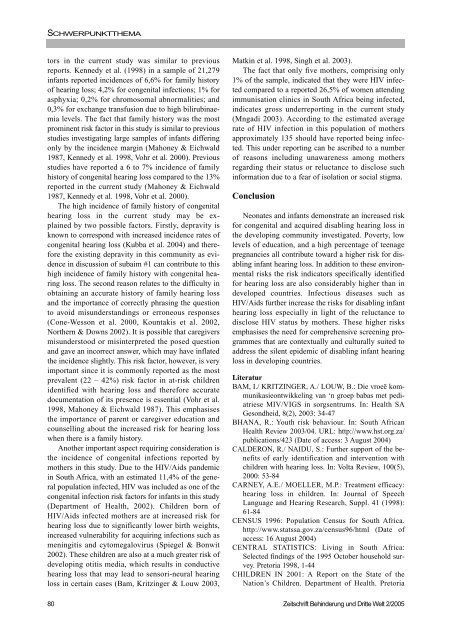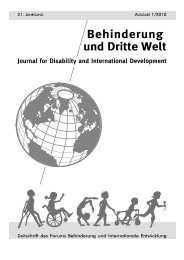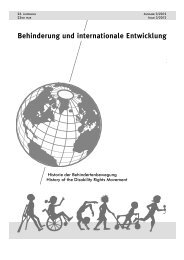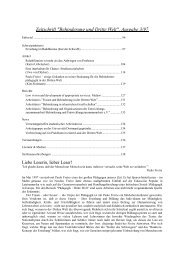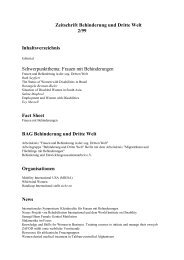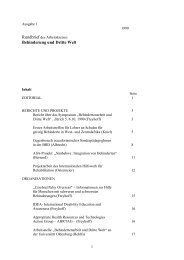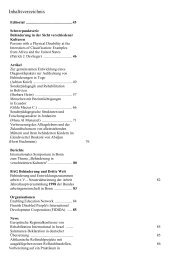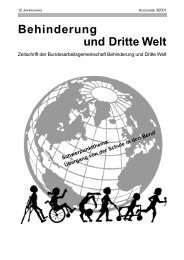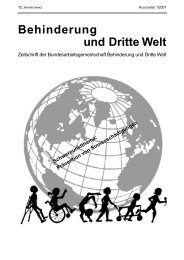Armut und Behinderung - Behinderung und Dritte Welt
Armut und Behinderung - Behinderung und Dritte Welt
Armut und Behinderung - Behinderung und Dritte Welt
You also want an ePaper? Increase the reach of your titles
YUMPU automatically turns print PDFs into web optimized ePapers that Google loves.
SCHWERPUNKTTHEMAtors in the current study was similar to previousreports. Kennedy et al. (1998) in a sample of 21,279infants reported incidences of 6,6% for family historyof hearing loss; 4,2% for congenital infections; 1% forasphyxia; 0,2% for chromosomal abnormalities; and0,3% for exchange transfusion due to high bilirubinaemialevels. The fact that family history was the mostprominent risk factor in this study is similar to previousstudies investigating large samples of infants differingonly by the incidence margin (Mahoney & Eichwald1987, Kennedy et al. 1998, Vohr et al. 2000). Previousstudies have reported a 6 to 7% incidence of familyhistory of congenital hearing loss compared to the 13%reported in the current study (Mahoney & Eichwald1987, Kennedy et al. 1998, Vohr et al. 2000).The high incidence of family history of congenitalhearing loss in the current study may be explainedby two possible factors. Firstly, depravity isknown to correspond with increased incidence rates ofcongenital hearing loss (Kubba et al. 2004) and thereforethe existing depravity in this community as evidencein discussion of subaim #1 can contribute to thishigh incidence of family history with congenital hearingloss. The second reason relates to the difficulty inobtaining an accurate history of family hearing lossand the importance of correctly phrasing the questionto avoid mis<strong>und</strong>erstandings or erroneous responses(Cone-Wesson et al. 2000, Kountakis et al. 2002,Northern & Downs 2002). It is possible that caregiversmis<strong>und</strong>erstood or misinterpreted the posed questionand gave an incorrect answer, which may have inflatedthe incidence slightly. This risk factor, however, is veryimportant since it is commonly reported as the mostprevalent (22 – 42%) risk factor in at-risk childrenidentified with hearing loss and therefore accuratedocumentation of its presence is essential (Vohr et al.1998, Mahoney & Eichwald 1987). This emphasisesthe importance of parent or caregiver education andcounselling about the increased risk for hearing losswhen there is a family history.Another important aspect requiring consideration isthe incidence of congenital infections reported bymothers in this study. Due to the HIV/Aids pandemicin South Africa, with an estimated 11,4% of the generalpopulation infected, HIV was included as one of thecongenital infection risk factors for infants in this study(Department of Health, 2002). Children born ofHIV/Aids infected mothers are at increased risk forhearing loss due to significantly lower birth weights,increased vulnerability for acquiring infections such asmeningitis and cytomegalovirus (Spiegel & Bonwit2002). These children are also at a much greater risk ofdeveloping otitis media, which results in conductivehearing loss that may lead to sensori-neural hearingloss in certain cases (Bam, Kritzinger & Louw 2003,Matkin et al. 1998, Singh et al. 2003).The fact that only five mothers, comprising only1% of the sample, indicated that they were HIV infectedcompared to a reported 26,5% of women attendingimmunisation clinics in South Africa being infected,indicates gross <strong>und</strong>erreporting in the current study(Mngadi 2003). According to the estimated averagerate of HIV infection in this population of mothersapproximately 135 should have reported being infected.This <strong>und</strong>er reporting can be ascribed to a numberof reasons including unawareness among mothersregarding their status or reluctance to disclose suchinformation due to a fear of isolation or social stigma.ConclusionNeonates and infants demonstrate an increased riskfor congenital and acquired disabling hearing loss inthe developing community investigated. Poverty, lowlevels of education, and a high percentage of teenagepregnancies all contribute toward a higher risk for disablinginfant hearing loss. In addition to these environmentalrisks the risk indicators specifically identifiedfor hearing loss are also considerably higher than indeveloped countries. Infectious diseases such asHIV/Aids further increase the risks for disabling infanthearing loss especially in light of the reluctance todisclose HIV status by mothers. These higher risksemphasises the need for comprehensive screening programmesthat are contextually and culturally suited toaddress the silent epidemic of disabling infant hearingloss in developing countries.LiteraturBAM, I./ KRITZINGER, A./ LOUW, B.: Die vroeë kommunikasieontwikkelingvan ‘n groep babas met pediatrieseMIV/VIGS in sorgsentrums. In: Health SAGesondheid, 8(2), 2003: 34-47BHANA, R.: Youth risk behaviour. In: South AfricanHealth Review 2003/04. URL: http://www.hst.org.za/publications/423 (Date of access: 3 August 2004)CALDERON, R./ NAIDU, S.: Further support of the benefitsof early identification and intervention withchildren with hearing loss. In: Volta Review, 100(5),2000: 53-84CARNEY, A.E./ MOELLER, M.P.: Treatment efficacy:hearing loss in children. In: Journal of SpeechLanguage and Hearing Research, Suppl. 41 (1998):61-84CENSUS 1996: Population Census for South Africa.http://www.statssa.gov.za/census96/html (Date ofaccess: 16 August 2004)CENTRAL STATISTICS: Living in South Africa:Selected findings of the 1995 October household survey.Pretoria 1998, 1-44CHILDREN IN 2001: A Report on the State of theNation’s Children. Department of Health. Pretoria80Zeitschrift <strong>Behinderung</strong> <strong>und</strong> <strong>Dritte</strong> <strong>Welt</strong> 2/2005


